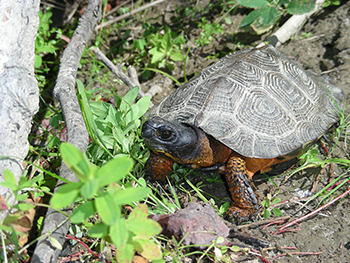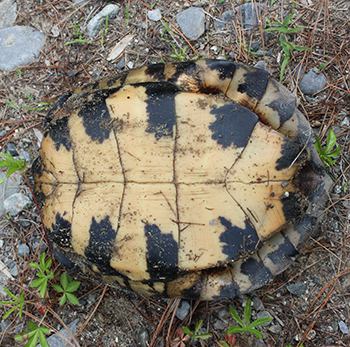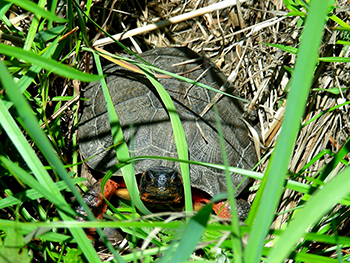Home → Fish & Wildlife → Wildlife → Species Information → Reptiles & Amphibians → Wood Turtle
Wood Turtle
Glyptemys insculpta
Please report your sighting of this Special Concern species as soon as possible.
On this page:

Photo: Jonathan Mays
Distinguishing Characteristics

Photo: Trevor Persons
- Medium-sized to large, carapace (top part of shell) approximately 5.5 to 10 inches in length
- Brown to grayish-brown sculpted carapace
- Limbs and head are brownish-gray to dark gray above, yellow or orange underneath
- Plastron (bottom part of shell) yellowish with large black blotches
Status and Distribution in Maine
- State Special Concern; Species of Greatest Conservation Need
- Uncommon
- Statewide

Photo: Jonathan Mays
Habitat
- Slow-moving streams or rivers with sandy or silty substrates
- Often in areas with deep pools and woody debris
- Semi-terrestrial, often found in vegetated floodplains of streams and adjacent forests
- Nests in areas of loose, sandy substrate such as sandbars along streams
Diet
- Omnivorous, diet includes leaves, grasses, berries, insects, earthworms, tadpoles, and newborn mice
- Will “stomp” for earthworms, with footfalls presumably mimicking rainfall that brings earthworms to the surface, where they are then eaten
Seasonal Changes
- Hibernates in winter in small ponds or beneath undercut banks of slow streams or rivers
Natural History Notes
- Mating occurs throughout the year, with egg laying occurring in June and July. Females may store sperm from for several years before laying fertilized eggs
- Long-lived and do not reach sexual maturity until 11 to 12 years old
- In some areas, the population has been negatively impacted by illegal collection for the pet trade
Share Your Sighting
Please report this Special Concern species as soon as possible!
There is much still to learn about the distribution and ecology of Maine's herpetofauna, and we encourage members of the public to share their photo-documented observations as part of the Maine Amphibian & Reptile Atlas Project (MARAP).
Submit your reptile or amphibian observation online
No service? No problem. Click here to download the survey to your device while connected, then take offline to collect observations from anywhere. Tip: The survey works best on Google Chrome and Safari.
Thank you for doing your part to help conserve Maine's reptiles and amphibians. For more information, please contact kevin.ryan@maine.gov.